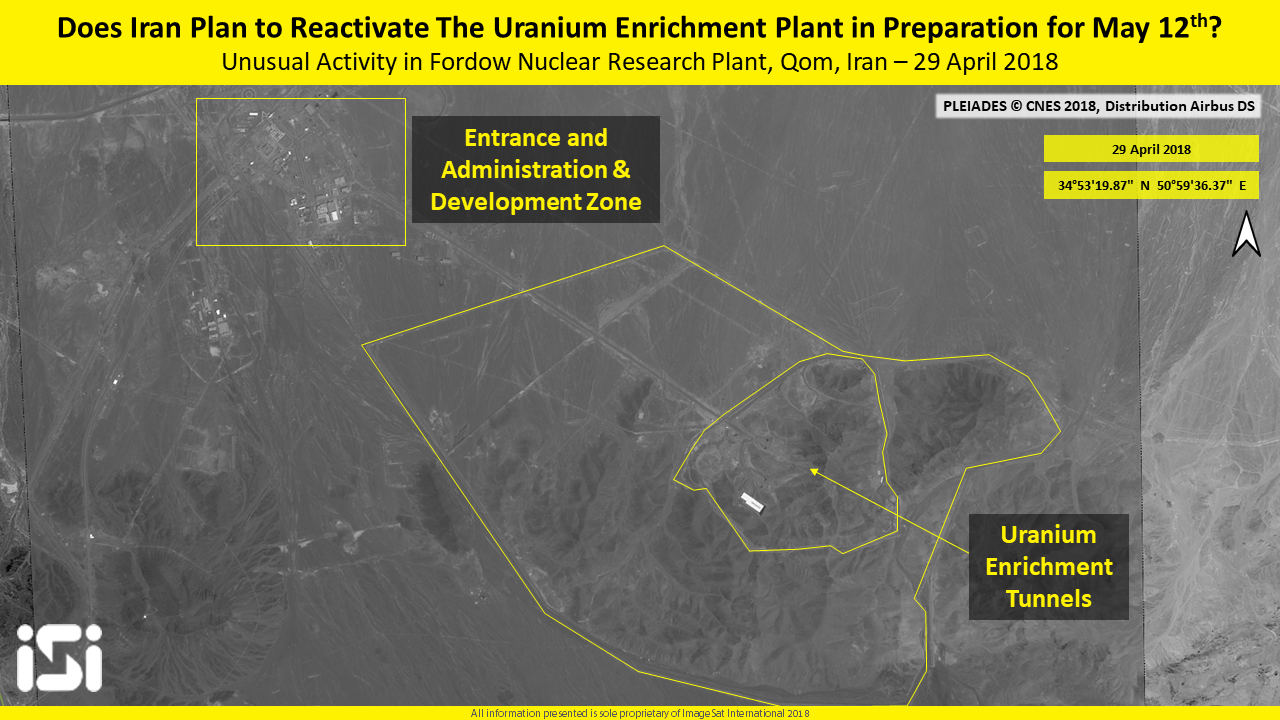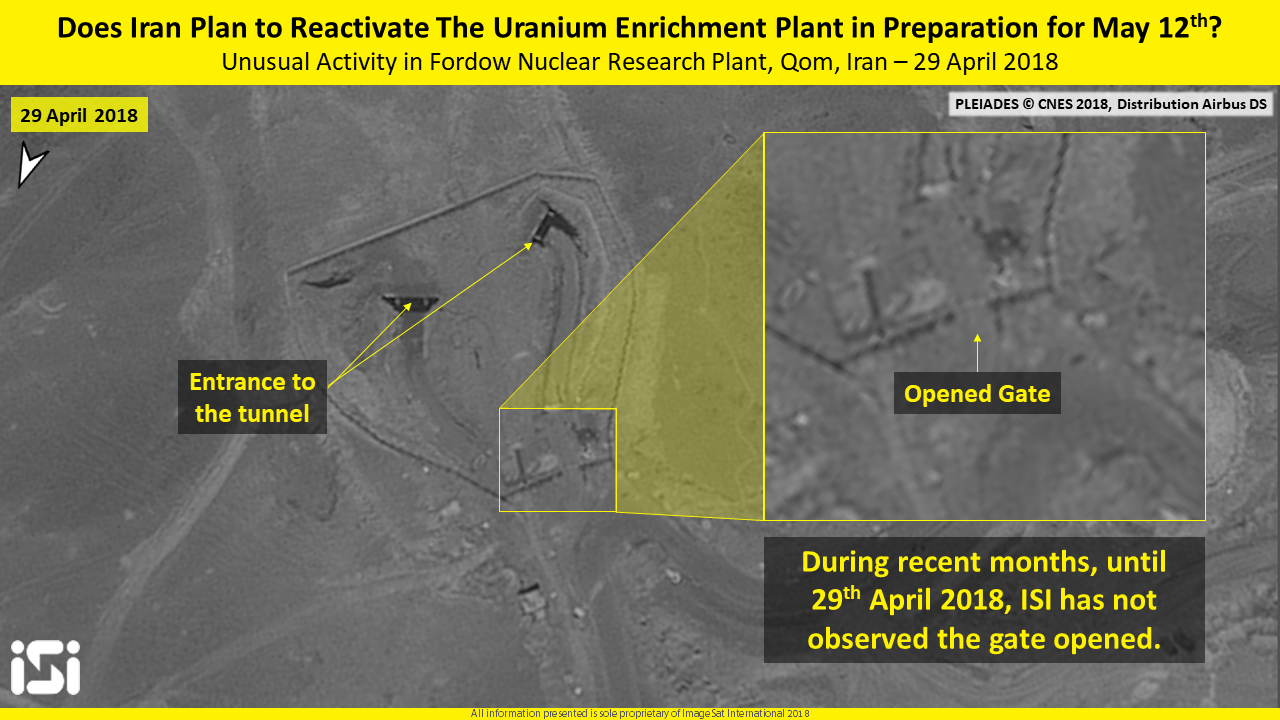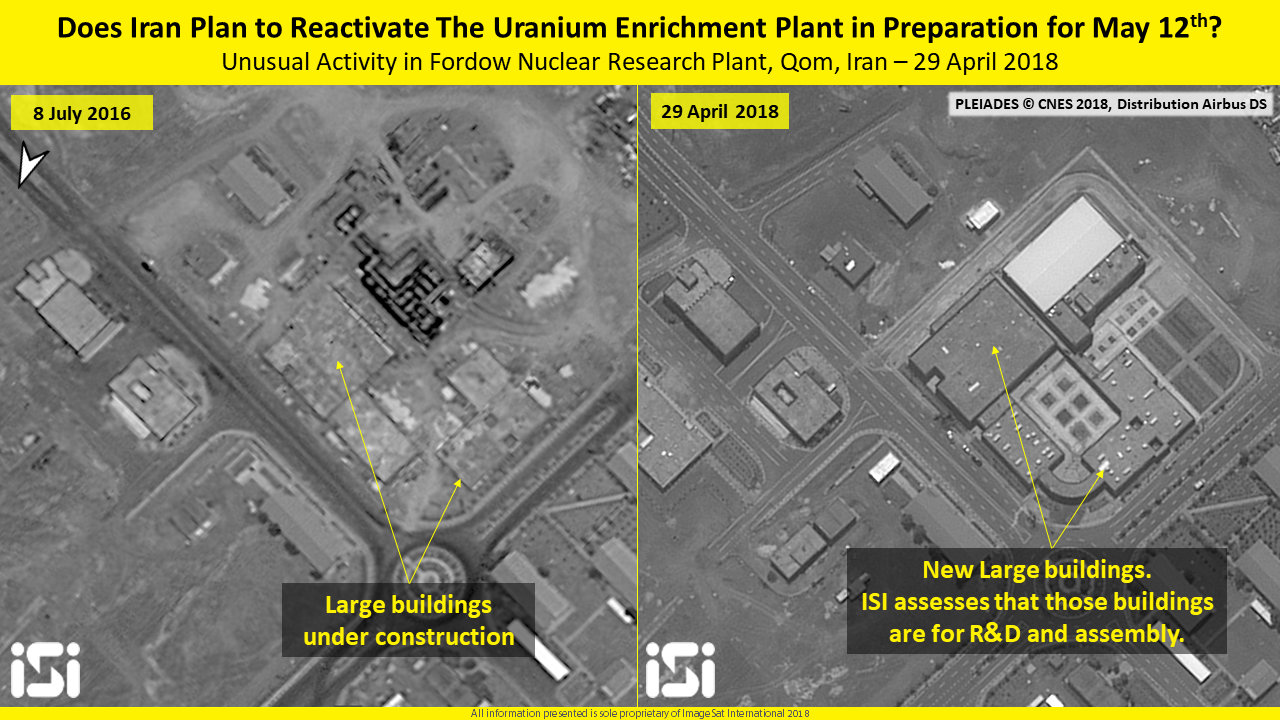Unusual
Activity at Iranian Nuclear Plant
From ELINT News, broadly sympathetic to Syrian interests
@ELINTNews
#BREAKING:
First Images from @imagesatint showing Iranian activity and possible
preparations to reactive Fordow Uranaium Enrichment Nuclear Plant in
Iran on May 12th, when it is anticipated the United States under
President Trump may pull out of the Iran Nuclear deal JCPOA
From zionist media
Israeli
satellite firm reports ‘unusual’ activity at Iran nuclear site
Images
of Fordo show full parking lot, open gates to 'uranium enrichment
tunnels,' but no indication of illicit activity
3
April, 2018
An
Israeli satellite imaging company on Thursday released images showing
what it described as “unusual” movement around the Iranian Fordo
nuclear facility, a one-time uranium enrichment plant buried deep
underground that was converted to a research center as part of the
2015 nuclear deal.
The
photographs, which show large numbers of vehicles at the entrance to
the facility and other signs of increased activity there, do not in
themselves indicate any violation of the nuclear accord, known
formally as the Joint Comprehensive Plan of Action, or JCPOA.
The
fate of the highly contentious nuclear agreement lies in the balance,
with US President Donald Trump set to decide whether or not America
will remain party to it ahead of a May 12 deadline.
The
underground site, which has been protected by the powerful S-300 air
defense system since 2016, was not shuttered as part of the accord,
but the types of activities allowed there were heavily curtailed.
Barring
a massive, heretofore undetected effort by Iran to bring Fordo back
online in violation of the JCPOA, the increased activity could likely
be attributed to an attempt by the Islamic Republic to imply that it
is prepared to begin enriching uranium at the site if the US pulls
out of the agreement.

A
satellite image from April 29, 2018, showing recent activity at the
Fordo nuclear facility in Iran. (ImageSat International ISI)
As
part of the JCPOA, Iran was forced to limit the number of centrifuges
allowed inside Fordo to 1,044, which would be kept in only one wing
of the facility, and agreed that it “will not conduct any uranium
enrichment or any uranium enrichment related [research and
development] and will have no nuclear material at the Fordo Fuel
Enrichment Plant (FFEP) for 15 years.”
The
International Atomic Energy Agency, which is tasked with monitoring
Fordo and Iran’s other nuclear facility under the JCPOA, last
released a report on the site in late February. Under the agreement,
IAEA monitors are entitled to inspect the facility regularly,
“including daily” if they so choose.
“Throughout
the reporting period, Iran has not conducted any uranium enrichment
or related research and development (R&D) activities, and there
has not been any nuclear material at the plant,” the IAEA reported
on February 22.
The
agency did not immediately respond to a Times of Israel request for
comment on the date of its latest inspection of the site.
Russian-made,
S-300 long-range missiles at the Fordo nuclear site in central Iran,
August 28, 2016.(Screenshot/Press TV)
The
pictures of the Fordo plant, which were taken on April 29, were
released by ImageSat International, a satellite imagery analysis firm
based out of Or Yehuda in central Israel. The company is largely run
by former members of the Israeli Air Force.
One
satellite photograph showed cars and buses filling the Fordo
facility’s parking lot. ImageSat said it “has not detected any
large presence of private vehicles nor buses” in recent months.
The
firm provided a second image from July 8, 2016, in which no vehicles
are visible. However, an aerial photograph from April 2, 2016, shows
at least 10 cars and two buses in the facility’s parking lot.
A
satellite image from April 29, 2018, showing recent activity at the
Fordo nuclear facility in Iran. (ImageSat International ISI)
A
satellite image from April 2, 2016, of the Fordo nuclear facility in
Iran. (Google Earth)
Another
image shows that a gate leading to what ImageSat refers to as
“uranium enrichment tunnels” was open on April 29. Before that,
the gate was last seen open on November 23, 2015. However, publicly
available satellite images of the site are few and far between.

A
satellite image from April 29, 2018, showing recent activity at the
Fordo nuclear facility in Iran. (ImageSat International ISI)
ImageSat
also noted the construction of new buildings at the site, which the
firm said appeared to be for research and development.
There
was no indication the buildings were used for research into uranium
enrichment, which is expressly forbidden under the accord. Other
types of scientific research are permitted at Fordo, so long as they
are approved by the IAEA.

A
satellite image from April 29, 2018, showing recent activity at the
Fordo nuclear facility in Iran. (ImageSat International ISI)
Construction
of the buildings began prior to implementation of the JCPOA in
January 2016 and was completed sometime in the past year, as the
structures can be seen in a Google Earth image of the site from
September 2017.
A
satellite image from September 15, 2017, of the Fordo nuclear
facility in Iran. (Google Earth)
The
facility is buried deep underneath a mountain, apparently to offer it
protection against potential Israeli or American airstrikes. It is
also located just outside the city of Qom, which is considered holy
to Shiite Muslims, making any attempted bombing of the site more
complicated.
Prime
Minister Benjamin Netanyahu discussed the Fordo facility this week,
as he unveiled a stunning operation by the Mossad intelligence
service, in which over 100,000 documents pertaining to Iran’s
nuclear weapons program were spirited from Tehran to Israel.
“You
all remember the Fordo facility? The Fordo Uranium Enrichment
Facility. This was a secret underground enrichment facility that the
Iranians built under a mountain. You don’t put thousands of
centrifuges under a mountain to produce medical isotopes. You put
them there for one reason: nuclear weapons, enrichment for nuclear
weapons,” Netanyahu said.
The
prime minister noted that construction of the facility took place
after Iran was meant to have ended its atomic weapons program —
known as Project AMAD — in 2003.
“You
also will not be surprised that Iran insisted on keeping Fordo. And
amazingly, the nuclear deal enabled it to do it,” he said.
While
no official announcement has been made by the US regarding the future
of the JCPOA, multiple sources told Reuters on Thursday that Trump
had “all but decided” to abandon the deal and impose new
sanctions against Iran.
Iranian
Foreign Minister Mohammad Javad Zarif on Thursday responded to
Trump’s threats to pull out of the deal with a threat of his own.
“If the US continues to violate the agreement or if it withdraws
altogether, we will exercise our right to respond, in a manner of our
choosing,” he said in an English-language video.







No comments:
Post a Comment
Note: only a member of this blog may post a comment.